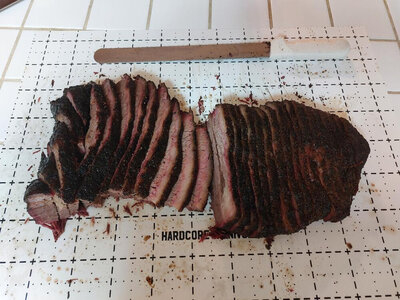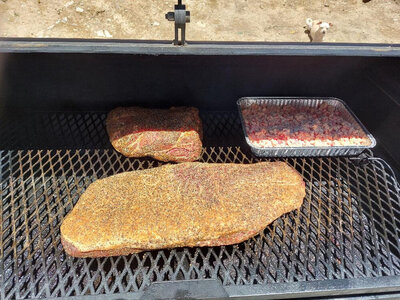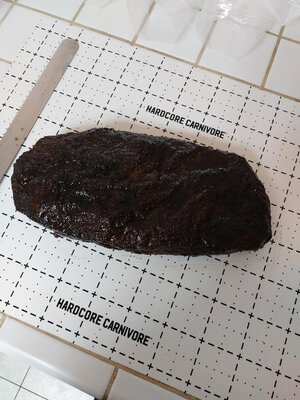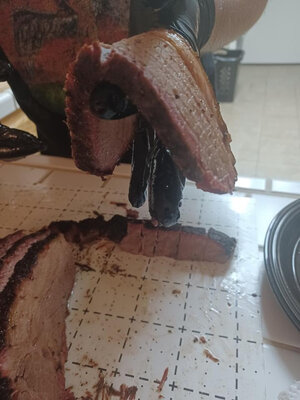Warning... this could get a little long winded lol. I have been sort of struggling with my brisket for a while now. Not that it's bad at all, it's just that I have not been happy with the texture.
The rub and overall flavor profile is 100% dialed to my satisfaction, and the appearance looks great, but every fricken single time it comes out TOO tender and basically over cooked. While it passes the hang test and the pull test no problem, I have NOT been able to get it to pass the bend test... if you hang it over a knife or your finger or whatever, it breaks every single time, and sometimes it shreds a little when slicing, especially when you start getting into the point. Being the perfectionist I am, I'm just not going to be happy with that.
So I decided a while back I was going to cook a brisket every single weekend until I get this figured out, and this weekend I FINALLY nailed it and I now know what my problem has been. RELYING ON PROBING to determine doneness, mostly by how much resistance there is, but also looking at what the temp was, and going off the fact that it should feel like probing peanut butter, which never happens until it gets to about 208-210 IT.... which always ends up over cooked.
Then, I have also been playing around with hot holds, because I really like cooking a brisket all day Saturday, with the intent on slicing in to it for lunch or dinner on Sunday. No need to wake up at the crack of dawn, or to stay up all night etc. Just a relaxing easy day. There was a part of me that was wondering if the hot hold was contributing to the over doneness, even though I ALWAYS rested the brisket down to 145-150 before puting in the hot hold, which lately has been a sous vide bath set at 145. I was wondering if 145 was too high as well, and that maybe I should go down to 141 to keep it as low as possible while staying at or above 140 100% of the time for obvious saftey reasons (The FDA says you can hold indefinitely at 140 or above, OR for 8 hours max at 135 - 139).
But then, there is something else that has bothered me lately as well. The old school guys never had these fancy Thermapens or Fireboards etc... they new when to wrap or when a brisket was done and ready to rest by certain visual and tactile cues, not by probing for tenderness or temp.
So... this weekend I decided I was going to take a chance, knowing I could end up with a tough dry brisket. I was not going to let a probe get anywhere near it and I was going to pull my brisket based solely on feel, using techniques described by some of the top BBQ Youtubers, like Jerby BBQ, Chud's BBQ, and Mad Scientist BBQ. And it worked!!!! It came out 100% perfect!!! Perfect tenderness that passed the hang test, the pull test, and the bend test, it was super juicy even all the way to the end of the flat. I will continue doing a brisket every weekend for the next few weeks just to ensure I can reproduce it.. but this is what I did:
1. Trimmed it to a nice and aerodynamic shape, in the style of Chuds, and Joe Yim who have IMO the BEST trim tutorials on Youtube.
2. Rub with a heavy layer of course black pepper, followed by a light layer of Kosher Salt, then a good coating of my own beef rub which has a lot of Lawry's, Granulated Garlic, and some other things. Used only water as a binder. All applied separately as recommended by Jirby BBQ, with the pepper on FIRST.
3. Smoked in the offset starting low at around 220, then gradually let it rise to 275 over the course of a few hours in an attempt to keep the thinner side of the flat from curling due to being blasted at high temp right out of the gate. It worked pretty well. I also spritzed just the outside edges with water once an hour after the first two hours just to ensure nothing got too crispy in order to avoid shredding on the cutting board later.
4. Waited to wrap until the bark had fully developed and passed the scratch test and had that deep black color. This is based on info from Harry Su (scratch test) and Mad Scientist BBQ ( Waiting until the bark had the deep black color).
5. Once it was ready to wrap based on the bark (about 7.5 hours in) I went with the foil boat method from Chud's BBQ. I've been playing around with this lately and really like it. I think I will be sticking with this method at least for now.
6. Then I waited for some other cues... with the plan of checking once every hour after the wrap.
7. The first cue was courtesy of Mad Scientist BBQ... I started feeling the fat cap with my finger... checking to see how soft it was, and waiting for it to feel soft enough that if I wanted to I could easily poke my finger right through it. I foil boated at 7:30PM... checked it 9PM.. it wasn't quite there but felt like it was getting close.
8. Checked it again at 9:30 still not quite but it was definitely getting softer. Then I tried feeling the underside of the brisket, lifting it slightly with my middle fingers right in the middle of the flat to see if it still felt super stiff, or if it felt like it had loosened up. That too wasn't quite right but felt pretty good so I knew I was close.
9. I waited anothert 30 minutes and checked again at 10:00PM. I felt the fat and Yep! If I wanted to I easily could have poked through it with my finger at every spot I tested on top, so then I tried feeling the underside again, lifting gently right in the middle of the flat with my two middle fingers and Yep! It was feeling nice and loose and felt like if I pressed up any harder it would break right through. So I called it done.
10. I placed it on a baking sheet and let it cool for two hours (no idea what the temp was because again I never let a probe get anywhere near it, although from prior tests I generally found it was about two hours to get it to come down from 210ish to 145 ish so that is what I went by.
11. at 12;00 midnight it was bagged and sealed and went in to a sous vide rest at 141.
I had a busy day today and things went way later than I intended. I pulled it out of the Sous Vide rest at 7:30PM, fearing I had let it go to long but NOPE! It sliced like butter, was very juicy even to the tip of the flat, and passed all of my tenderness tests with no problem.
So I am super happy (and a little proud of myself) to say I think I have FINALLY dialed this tricky brisket in!!!!!
My key take away was that going by probe tenderness, even the "should feel like sticking a probe in peanut butter made me think it should be softer than it really should be, causing me to continuously over cook my briskets due to waiting to feel for a tenderness that just in general is over cooked. Now that I know what the top and bottom should feel like based on touch, I don't think I will ever gauge by any other method.
Unfortunately I didn't take a bunch of pictures, just when I through it on the smoker yesterday, and after I had sliced it tonight...


The rub and overall flavor profile is 100% dialed to my satisfaction, and the appearance looks great, but every fricken single time it comes out TOO tender and basically over cooked. While it passes the hang test and the pull test no problem, I have NOT been able to get it to pass the bend test... if you hang it over a knife or your finger or whatever, it breaks every single time, and sometimes it shreds a little when slicing, especially when you start getting into the point. Being the perfectionist I am, I'm just not going to be happy with that.
So I decided a while back I was going to cook a brisket every single weekend until I get this figured out, and this weekend I FINALLY nailed it and I now know what my problem has been. RELYING ON PROBING to determine doneness, mostly by how much resistance there is, but also looking at what the temp was, and going off the fact that it should feel like probing peanut butter, which never happens until it gets to about 208-210 IT.... which always ends up over cooked.
Then, I have also been playing around with hot holds, because I really like cooking a brisket all day Saturday, with the intent on slicing in to it for lunch or dinner on Sunday. No need to wake up at the crack of dawn, or to stay up all night etc. Just a relaxing easy day. There was a part of me that was wondering if the hot hold was contributing to the over doneness, even though I ALWAYS rested the brisket down to 145-150 before puting in the hot hold, which lately has been a sous vide bath set at 145. I was wondering if 145 was too high as well, and that maybe I should go down to 141 to keep it as low as possible while staying at or above 140 100% of the time for obvious saftey reasons (The FDA says you can hold indefinitely at 140 or above, OR for 8 hours max at 135 - 139).
But then, there is something else that has bothered me lately as well. The old school guys never had these fancy Thermapens or Fireboards etc... they new when to wrap or when a brisket was done and ready to rest by certain visual and tactile cues, not by probing for tenderness or temp.
So... this weekend I decided I was going to take a chance, knowing I could end up with a tough dry brisket. I was not going to let a probe get anywhere near it and I was going to pull my brisket based solely on feel, using techniques described by some of the top BBQ Youtubers, like Jerby BBQ, Chud's BBQ, and Mad Scientist BBQ. And it worked!!!! It came out 100% perfect!!! Perfect tenderness that passed the hang test, the pull test, and the bend test, it was super juicy even all the way to the end of the flat. I will continue doing a brisket every weekend for the next few weeks just to ensure I can reproduce it.. but this is what I did:
1. Trimmed it to a nice and aerodynamic shape, in the style of Chuds, and Joe Yim who have IMO the BEST trim tutorials on Youtube.
2. Rub with a heavy layer of course black pepper, followed by a light layer of Kosher Salt, then a good coating of my own beef rub which has a lot of Lawry's, Granulated Garlic, and some other things. Used only water as a binder. All applied separately as recommended by Jirby BBQ, with the pepper on FIRST.
3. Smoked in the offset starting low at around 220, then gradually let it rise to 275 over the course of a few hours in an attempt to keep the thinner side of the flat from curling due to being blasted at high temp right out of the gate. It worked pretty well. I also spritzed just the outside edges with water once an hour after the first two hours just to ensure nothing got too crispy in order to avoid shredding on the cutting board later.
4. Waited to wrap until the bark had fully developed and passed the scratch test and had that deep black color. This is based on info from Harry Su (scratch test) and Mad Scientist BBQ ( Waiting until the bark had the deep black color).
5. Once it was ready to wrap based on the bark (about 7.5 hours in) I went with the foil boat method from Chud's BBQ. I've been playing around with this lately and really like it. I think I will be sticking with this method at least for now.
6. Then I waited for some other cues... with the plan of checking once every hour after the wrap.
7. The first cue was courtesy of Mad Scientist BBQ... I started feeling the fat cap with my finger... checking to see how soft it was, and waiting for it to feel soft enough that if I wanted to I could easily poke my finger right through it. I foil boated at 7:30PM... checked it 9PM.. it wasn't quite there but felt like it was getting close.
8. Checked it again at 9:30 still not quite but it was definitely getting softer. Then I tried feeling the underside of the brisket, lifting it slightly with my middle fingers right in the middle of the flat to see if it still felt super stiff, or if it felt like it had loosened up. That too wasn't quite right but felt pretty good so I knew I was close.
9. I waited anothert 30 minutes and checked again at 10:00PM. I felt the fat and Yep! If I wanted to I easily could have poked through it with my finger at every spot I tested on top, so then I tried feeling the underside again, lifting gently right in the middle of the flat with my two middle fingers and Yep! It was feeling nice and loose and felt like if I pressed up any harder it would break right through. So I called it done.
10. I placed it on a baking sheet and let it cool for two hours (no idea what the temp was because again I never let a probe get anywhere near it, although from prior tests I generally found it was about two hours to get it to come down from 210ish to 145 ish so that is what I went by.
11. at 12;00 midnight it was bagged and sealed and went in to a sous vide rest at 141.
I had a busy day today and things went way later than I intended. I pulled it out of the Sous Vide rest at 7:30PM, fearing I had let it go to long but NOPE! It sliced like butter, was very juicy even to the tip of the flat, and passed all of my tenderness tests with no problem.
So I am super happy (and a little proud of myself) to say I think I have FINALLY dialed this tricky brisket in!!!!!
My key take away was that going by probe tenderness, even the "should feel like sticking a probe in peanut butter made me think it should be softer than it really should be, causing me to continuously over cook my briskets due to waiting to feel for a tenderness that just in general is over cooked. Now that I know what the top and bottom should feel like based on touch, I don't think I will ever gauge by any other method.
Unfortunately I didn't take a bunch of pictures, just when I through it on the smoker yesterday, and after I had sliced it tonight...









